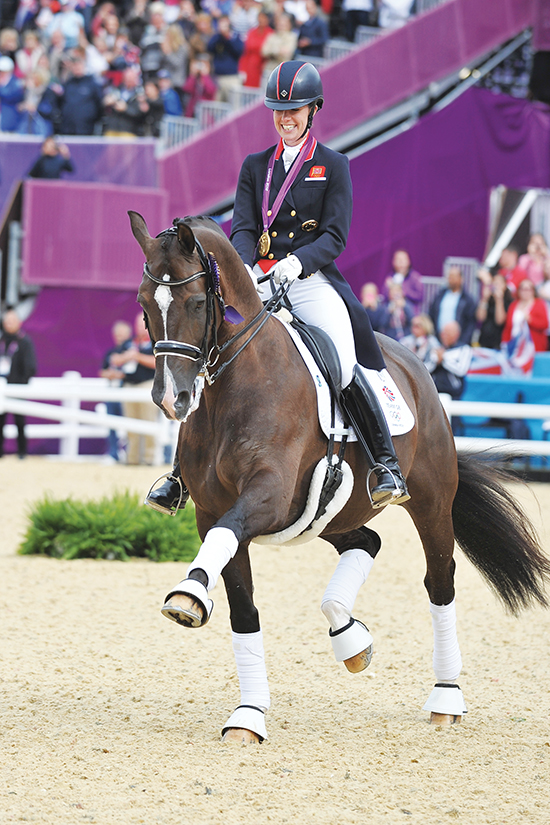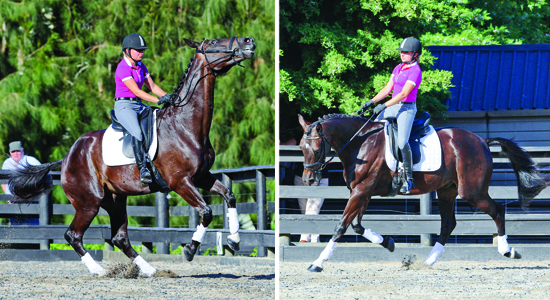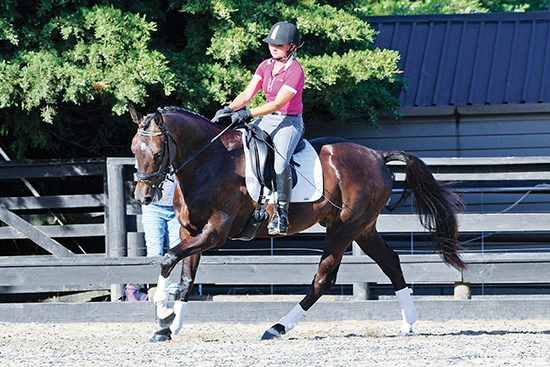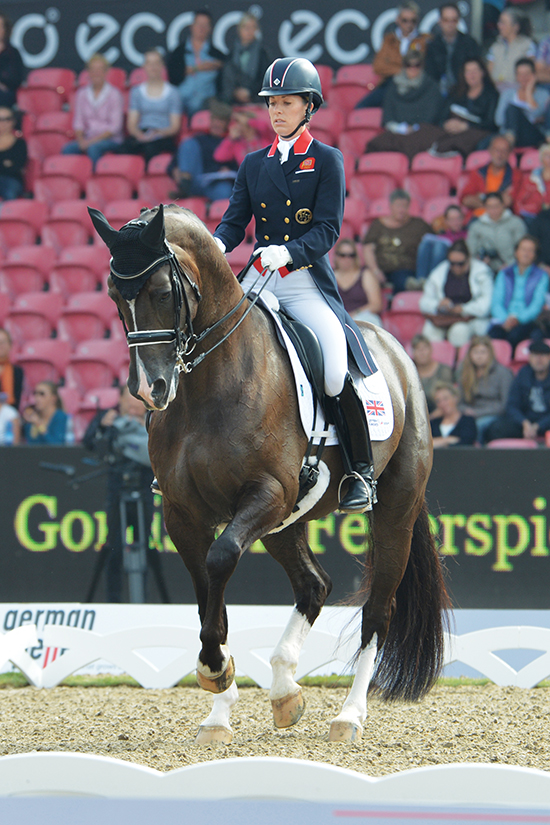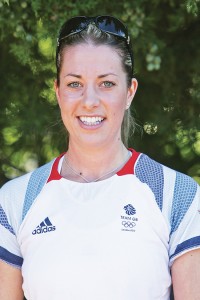 We got up close and personal with British dressage superstar Charlotte Dujardin during her two-week trip to New Zealand in January. She spoke about Valegro being taken off the market, her own training philosophies and why New Zealand dressage riders need to sharpen up.
We got up close and personal with British dressage superstar Charlotte Dujardin during her two-week trip to New Zealand in January. She spoke about Valegro being taken off the market, her own training philosophies and why New Zealand dressage riders need to sharpen up.
It’s hard not to be a little star-struck when you meet somebody as famous as Charlotte, the face and swingy blonde pony tail instantly recognizable from television and a hundred magazine articles. And I’m clearly not the only one: one rider was literally shaking before her lesson, although any nerves must have quickly dissipated as Charlotte got down to the very serious business of teaching. The intensity of her training wasn’t surprising; obviously you don’t get to win gold medals without breaking a sweat, even if perspiration looks a long way from the Charlotte ‘look’: the designer sunglasses and impractically long fingernails that don’t look like they’ve ever been anywhere near a horse – Charlotte is the Queen of Bling and a self-proclaimed shopaholic.
Although Charlotte shies away from media attention, and is much more in her element teaching and riding than conducting interviews, she is nevertheless friendly and funny once you pin her down to chat. However, it did take Charlotte a little while to adjust to dressage, Kiwi-style. She’d been warned by Greg Smith, a close friend and Kumeu-based event/dressage rider who orchestrated Charlotte’s visit, that the standard might not be quite what she is used to at home.
“But actually, the horses have been pretty good and the riders are good. It’s just that everybody is a lot more chilled out and laid back here,” she reflected. “You say kick and nobody kicks! You say go and their go is my working canter. Everything has got to be sharper. I think people here are happy for a six or a seven, whereas we’re always trying to go for those nines and tens. It’s incredible how you can change a picture just by putting a bit more motivation and lift into it. It’s been great to see the difference.”
“Talking to the riders it seems like everybody leaves their horses out in the field overnight, which we just wouldn’t do. That’s great if you’ve got a really sharp horse, or a young horse – we leave our young horses out overnight – but with your top competition horses, there’s no way you can do it from the grass. They’re out all day, they eat all night and then they come in and work…that’s like you eating a full meal and then going to the gym!”
Charlotte and Valegro, Champions
Because Charlotte teaches on Wednesdays and Saturdays, her horses only school four days a week: Monday, Tuesday, Thursday and Friday. On the other days, they hack and/or go on the water treadmill, and Sunday is a day off. “If you ask most people, they train five or six days a week. For us, it’s not about how much you school them. Our horses are always fresh to come into the school. I think it’s great to break it up and let them do something different. In the summer they go cantering around the fields, they hack, they do all sorts.”
Charlotte’s horses, however, are a lot fitter than the Kiwi equines she encountered. “I think it’s just we push ours, whereas everybody is so laid back here, aren’t they? You have to push to get somewhere. You don’t become a top gymnast by not pushing yourself to the limit.”
The 28-year-old is no slouch in the fitness stakes herself. Tiny and toned, she protests ‘don’t look at me at the moment, because we’ve had Christmas-time and I’ve just let loose. I feel horrendous now – I’m dreading going home!’ Usually Charlotte goes to the gym and works with a personal trainer at least three or four times a week, even though she’s so busy riding and teaching she doesn’t get there until 8 o’clock at night. “I absolutely love it. I’m missing it now, as it makes you feel so much better. I do a lot of core strength – I can stand on the gym ball, do squats on the gym ball. And obviously everybody has a weaker side and a stronger side, so I have to work on my left side and do a lot of resistance with my left leg.”
Describing herself as an adrenalin junkie, Charlotte relished the chance to go white-water rafting and bungy jumping during her New Zealand working holiday, and had a fabulous time taking Melissa Steed’s horse for a gallop along Muriwai Beach. “It was brilliant – we went for a good old blast, flat out,” she enthused. “If I lived here, I’d be out there all the time.” Charlotte was joined by her fiancé Dean Wyatt Golding, a former marathon runner and triathlete, who had only previously ridden half a dozen times in his life. “It’s quite hard teaching him on my horses, because they are so sensitive, and when his legs go in the wrong place…well, he has fallen off a few times! But he wanted to go for a ride down on the beach with us, and although he hasn’t ridden for over a year he picked up rising trot straight away and he went for a good gallop down the beach.”
At home, Charlotte earns her living by teaching two full days a week, and trains all sorts. In Auckland, her riders varied from adult amateurs competing at Level 2/3 through to Grand Prix riders. “I’m not a snob. It doesn’t matter to me what standard I teach. If I can give them maybe two or three tips to go away with then that’s what they’ve paid me to do. If that means just walk, trot and canter on a circle and I can do something to help them I get as much of a buzz out of that as I do out of teaching someone at Grand Prix. People are always like ‘I’m not good enough for you’, but it’s not about being good enough, it’s about helping. I’m not here to sit and criticize – I’m here to help.”
One of the riders Charlotte worked with in NZ was Charmain Pearson-White and her five year old, Wimborne Conniston (Conny). Left to right: Charlotte felt Conny was too long and round in his outline for a competition frame; Charlotte said Conny was also too curled to the inside. She wanted Charmain to keep his head and neck straighter to the outside; Charmain began to get Conny in a bit more of an uphill frame.
Don’t get the wrong impression though: there’s nothing warm and fuzzy about Charlotte’s teaching. She’s honest and authoritative and if something’s terrible, she’ll let you know in no uncertain terms.
“There’s no point me sitting here telling everybody it’s good when I know everything can be better. I hate watching teaching when people just sit there and say ‘Good, good.’ I find that really frustrating. I correct things the way I would if I was riding and try to put that feeling to other riders. The main thing is making riders a lot more quick-thinking. If you make a mistake you’ve got to correct it straight away, not leave it until you’re half-way around the arena – the horse is not going to learn from that.”
Charlotte’s trip to New Zealand came shortly after the announcement her beloved Valegro had been taken off the market – his owners Carl Hester and Roly Luard have decided to keep him, ending a tumultuous year for Charlotte. She is, naturally, ‘ecstatic’.
“He’ll be at home with us forever, until he dies,” she smiles. “The whole of last year was a rollercoaster, because at every show I didn’t know whether I was going to keep the horse. I went into every competition thinking it could be my last ride.”
The original plan was to sell the dazzlingly beautiful ‘Blueberry’ after the Olympics, yet buyers were not forthcoming, perhaps deterred by the price-tag (rumoured to be around Aus$11.2 million) or the strength of his partnership with Charlotte. However, Charlotte believes he would probably give somebody else what he gives her. “Obviously I know him inside out, which makes it a bit more special. But if you ride a horse like that…it’s one in a million isn’t it? You can’t find those sorts of horses – it’s just a freak of nature that comes along.”
“I don’t doubt that what Carl and I have done has made him a really good horse, but the work ethic that horse has, the love and determination and the will to do it is phenomenal. I can ride him at home in the arena and I can put him in a competition arena and he does exactly the same thing – how many horses go the same at a competition? They don’t. They’re either backing off or they know they’ve got you in there and you have to work harder for it. He just goes in, no matter what and performs, so as a rider he fills you with so much confidence. At home a 76-year-old lady hacks him out on the roads. All the girls hack him. I put kids on him.”
And while Charlotte and Carl’s relationship went through a tricky patch post-Olympics, the golden duo of British dressage has bounced back stronger than ever, with a string of Grand Prix horses and several exciting younger ones coming up.
“Carl is closer than a friend to me – he’s more like family now. We work so closely together. He takes the piss out of me, I take the piss out of me; I tell him what to do, even though he doesn’t like it and he shouts and screams at me, and that’s what I like – I like having that criticism.”
Left: Conny decided collected canter work in the hot sun was hard work and he’s had enough! Charlotte told Charmain not to give up, but to keep the contact and keep turning left; Right: Charmain got Conny back on track with a really forward trot around the arena.
Born in Enfield, Charlotte’s been called an Essex girl, but she explains she didn’t really stay there long enough to qualify. Her rags-to-riches story is well-documented – she grew up with a horsey mum and an older sister, Emma-Jayne, who also rode. She first sat on a horse at the age of about two, and started her career show jumping and showing, with much success at Britain’s Horse of the Year Show in showing classes. “We never had the money to go and buy top ponies, so I rode all the ones nobody else wanted because they were so naughty and then we had to sort them out,” she explains. “I used to go all over the place, trying to qualify everyone else’s ponies for them, because they couldn’t do it, and then they would ride them at the championships. I learnt so much from that, riding all those naughty ponies. I loved it – for me it was a huge challenge, and I’m still like that now. I love the naughty ones!”
Charlotte took up dressage at the age of 17, and went to Judy Harvey as a working pupil for four years. Her first dressage horse, Fernandez, was purchased with her grandmother’s inheritance. A German-bred horse by Florestan, he was only three years old and wasn’t particularly expensive, although for the Dujardins it was a lot of money at the time. “We knew nothing about dressage and we didn’t know if he was going to be a good horse, we just bought him because he bolted with somebody around the arena and we thought it would be perfect for me because it was fast! He just happened to be the most amazing Grand Prix horse.”
Having trained him to Grand Prix herself, it was an awful wrench for Charlotte to sell the horse, but she had no option. “Financially we didn’t have the money to back myself to keep going. It’s such an expensive hobby and when you’re travelling abroad, away from home and not making any money it’s even harder. So it was just something we had to do and I was really fortunate that my Mum then gave me some money to be able to buy a house.”
Charlotte went to work for Carl when she was just 21, and she started riding Valegro when he was rising five. Carl had done a couple of young horse classes on him, and he was being ridden by Lucy Cartwright, who worked for Carl at the time. “He was hot. He’s always been hot, but in a good way, in a way that doesn’t make you think you’re going to be off at any point. He’s just sensitive. He used to canter and I’m not joking, four strides down the long side and you were there, it was huge, massive, and that was partly the reason I got the ride because Lucy was so small, bless her, he was just carting her around the arena.”
Despite his obvious talent, Charlotte says there was a time when Carl was unsure whether Blueberry would do the piaffe-passage. He was so nervous and whip-shy that Charlotte could never carry a whip or he’d panic and melt down. “We normally teach them to jog with the whip, just to help them learn to bounce a little bit, but it took me ages because he just kept cantering. Until he learned to jog, I couldn’t get the piaffe steps. We had to just keep doing really small bits and once he clicked what we wanted that was it, we were flying.”
Working on the medium canter-collected canter transitions on the circle is hard work for Conny, but it helps keep him in front of the leg and more uphill in his frame.
The rest of course is history – Charlotte and Valegro won a team gold medal at the Europeans just five months after they did their first Grand Prix. In their second year of Grand Prix, they won gold medals at the Olympics and notched up world records – an unprecedented rise in the world of dressage.
“I did an insane amount of stuff and it took me until January last year to kind of stop and think back on what we’d achieved. It was go, go, go, so I didn’t really get the time to appreciate what I’d done.” The media hype and attention that surrounded Charlotte was a surprise and somewhat overwhelming – she and Dean were even ‘papped’ while on holiday in Barbados.
“For me, that was a bit surreal. I’m not joking you, I get fan-mail every day and people telling me how I’ve inspired them to pick up riding – I think oh poor husbands!” she jokes. “After the Olympics I had men who had no idea about horses saying I was the girl on the dancing horse and I’d made them cry. That’s amazing for our sport. It’s exactly what we need.”
It does lead to the question, of course, what comes next – what’s left to achieve when you’ve already reached the pinnacle of your sport at the age of 28? And does she have another Valegro in the wings?
“I definitely want to do the World Equestrian Games. I think that’s the last thing I’ve got left to conquer. But you just keep going, don’t you. You always want to do better. I know in my Grand Prix I can still score higher, it’s just making no mistakes, and that’s the thing – it’s being able to go for that knife edge, where you’re almost going to make a mistake but you don’t.”
Besides Valegro, Charlotte currently has the ride on Carl’s former mount Uthopia, and Carl himself has three other Grand Prix horses. Within days of returning from her New Zealand trip Charlotte was off to Amsterdam for a World Cup qualifier, as this year she’s contesting the World Cup series for the first time with Valegro. He will then have a quieter period through the middle of the year and she’ll pick him up just before the Worlds. “He only did four shows last year. If you just keep pushing and pushing it ruins them. He’s such a sound, fit horse I don’t want anything to go wrong. You’ve got to look after them.”
Charlotte also has three young horses of her own; two four-year-olds and a five-year-old. The five-year-old, Johnny Cash, is a Warmblood cross, out of a Thoroughbred mare. Charlotte found him cheap in a field as a three-year-old and says he’s super talented, although he’s also quite naughty and has bucked her off a number of times. “He was very cold backed. I’ve probably fallen off and hurt myself more times on him than anything. Luckily I’ve never broken anything, but I’ve hit the ground very hard!”
The four-year-olds are both Dutch-bred, one by Jazz and the other by Ampère. “They’re all very different but they’re really, really exciting and I think they’re all good enough to be Grand Prix horses although they haven’t competed yet. At home I can’t ride the lower levels, which would be your Level 1 and 2 – we are banned from riding those – and they’re not ready for Medium (Level 4) yet. There are young horse classes, but I don’t really like doing those because they just want to see them move with their legs around their ears and huge trots and huge canters, but to me that doesn’t make a top Grand Prix horse, so I don’t bother.”
Charlotte says she can absolutely imagine having the same special partnership she has with Valegro with another horse in the future – she had it with Fernandez, and could ride the Grand Prix on him in a head collar and rope, bareback. “I think it’s all about having them from a young horse. Along the way you build such a huge partnership and learn so much about your horse.”
While Carl has always been Charlotte’s equestrian hero and mentor, even now she loves going to shows and watching other riders. “You always learn small things from each person, just by watching. Everybody does everything slightly different, so I don’t watch just one person but I do love watching Edward Gal. I think he’s incredibly clever how he rides and the control he gets over his horses is phenomenal. It’s almost like they become a computer rather than a horse, it’s unbelievable.”
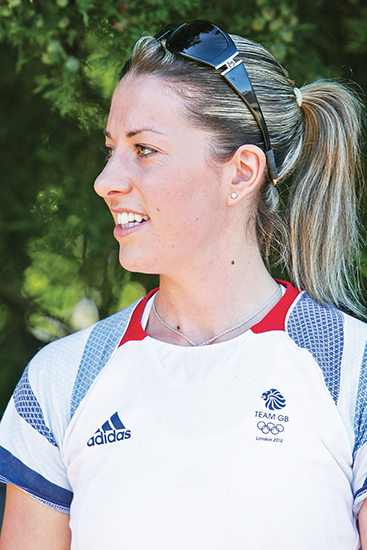 FIVE THINGS YOU DIDN’T KNOW ABOUT CHARLOTTE
FIVE THINGS YOU DIDN’T KNOW ABOUT CHARLOTTE
Charlotte calls Carl Hester ‘Granddad’ and he dubbed her ‘Edwina’ (after Edward Scissorhands – because he says she used to be a bit strong and wooden in her movements!)
She has a pair of lucky Pikeur breeches which she didn’t change throughout the Olympics. When she got her first world record in Hagen, Charlotte wrote ‘world record’ in them with permanent marker and has worn them ever since. They now hold three world records and five gold medals!
Her favourite food is smoked salmon
She hated school, because she couldn’t see how it had any relevance to what she wanted to do with her life – horses
If she hadn’t made it as a rider, she would have liked to work in an animal rescue centre, because she’s always loved caring for animals
This article originally appeared in NZ Horse & Pony, and in the March 2014 issue of THM.


